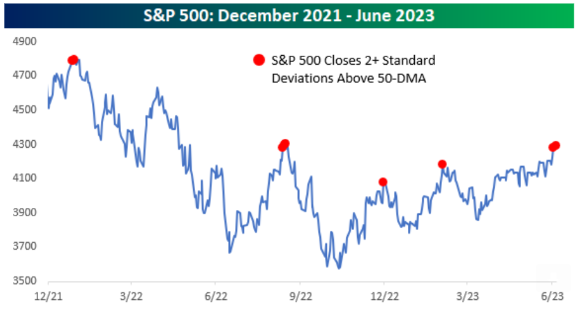Technology bears fought Monday to a modest victory as an extremely strong early rally was mostly reversed, states Jon Markman, editor of Strategic Advantage.
The Nasdaq 100 closed at 14,667, a gain of only 0.1%. At the session high, the benchmark index was less than 0.3% from filling its April 2022 gap at 14,775. It is important to keep in mind that since April, bears have been conceding a rally to this level. It has been a magnet, pulling the index higher despite declining corporate profitability, a regional banking crisis, and hawkish rhetoric from the Federal Reserve.
Bears still believe, against all odds, that investors will eventually come to their senses and send share prices careening lower after the gap at 14,775 gets filled. This is probably wishful thinking. Bulls are buying every major dip. And sentiment is building around the idea that the economy will avert a nasty recession and the Federal Reserve will stop lifting its interest rate target as soon as this month.
Moreover, evidence is growing that the artificial intelligence growth story is real following the Nvidia (NVDA) earnings report. The reversal from the high on Monday corresponded with the pullback in Apple (AAPL) shares after the iPhone maker revealed its new mixed-reality headset. This weakness had all the earmarks of a sell-the-news profit-taking event.
I would not be surprised if technology shares retreat further in the middle of this week, however, that weakness will be a buying opportunity, assuming the gap at 14,775 goes unfilled. There is near-term support for the benchmark at 13,910, the rising 20-day moving average. Expect aggressive buying into any pullback to that level.
The NDX Loop: Members earned an overall profit of 16.5% by buying ProShares Ultra QQQ (QLD), a 2x leveraged Nasdaq 100 fund, on May second and then selling in halves higher for gains of 10.6% and 22.4%. That’s great for a hold of just three weeks.
Let’s try to do that again. I’m hunting a new low-risk entry. I will send instructions when ready.
Behind the Headlines: The Dow dropped 0.6% to 33,562.9, while the Nasdaq Composite ticked 0.1% lower to 13,229.4. Industrials saw the steepest decline among sectors, while communication services led the gainers. Breadth favored decliners five-three. There were 98 new lows vs 276 new highs.
In economic news, two surveys painted a mixed picture of US services sector activity in May, with the Institute for Supply Management's index showing a deceleration in growth, while S&P Global's measure indicated a gain.
The ISM purchasing managers' index last month fell to 50.3 from 51.9 in April, versus the 52 consensus on Econoday. Data from the last three months indicate the services sector has "plateaued, and we are likely to see a pullback into contraction at some point in the coming months," Jefferies said in a note. I’m skeptical.
S&P Global said its services PMI gauge increased to 54.9 in May from 53.6 the prior month, marking the fourth successive monthly gain and the fastest rate of expansion since April 2022. Wall Street was looking for 55.1.
The US two-year yield fell 2.9 basis points to 4.47% on Monday, and the ten-year rate was little changed at 3.69%.
Overbought or Overwrought?
Here’s a brief comment by excellent Bloomberg opinion columnist John Authers amid a very long discussion on whether a new bull market will ensue now that the S&P 500 has come so close to a 20% advance from the October low. The accompanying Bespoke Investment Group graphic is compelling and worth your consideration:
Market technicians complain that the market looks overbought, which suggests that there is some froth at present. That calls into question how much we should trust the positive signal being sent by the 20% rise from the trough. On Friday, when the benchmark gauge scaled new 2023 highs, it also closed at its most overbought level since July 2021. Bespoke's graph below shows the S&P 500 closing 2.47 standard deviations above its 50-day moving average to fall into the “extreme category.”
That’s only a short-term indicator, but it’s notable that every time the stock market has rushed this far ahead of itself since the bear market started, a selloff has followed.

Learn more about Jon Markman here...





















